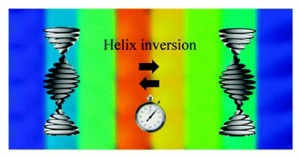Liquid crystals are an area of intense interest due to their potential use in smart materials such as displays. Cholesteric liquid crystals are of particular interest due to their helical nature and their ability to selectively reflect light over a narrow range of wavelengths. This range can be modified by the inclusion of photo-responsive dopants.
Dopants include overcrowded alkenes which undergo a stable to unstable (cis–trans) transition upon irradiation with UV light. This results in an unwinding and eventual inversion of the cholesteric helix. This is accompanied by a red-shift of the reflection band which then returns close to the original position. However, the handedness of the helix has changed, and therefore the polarization of the light has also changed.

Helix inversion of a cholesteric liquid crystal.
An important parameter with all liquid crystals is their relaxation step which needs to be suitable for the envisioned application. Nathalie Katsonis and her team have studied cholesteric liquid crystals doped with overcrowded alkenes in an effort to find a general paradigm correlating relaxation kinetics with the rate of helix inversion.
In their recent Communication, Katsonis’ group shows that the helix relaxation kinetics are fully determined by the kinetics of the light-sensitive dopants. The relaxation of the dopants from unstable to stable is unperturbed by the liquid crystalline environment.
On the other hand, the presence of the dopants can dramatically accelerate helix inversion. Therefore the inversion can be time-programmed by judicious choice of the dopant. This opens up the great potential of fine tuning cholesteric liquid crystals for smart materials with sophisticated functions.
For more, read this ‘HOT’ Chem Comm article in full:
Time-programmed helix inversion in phototunable liquid crystals










